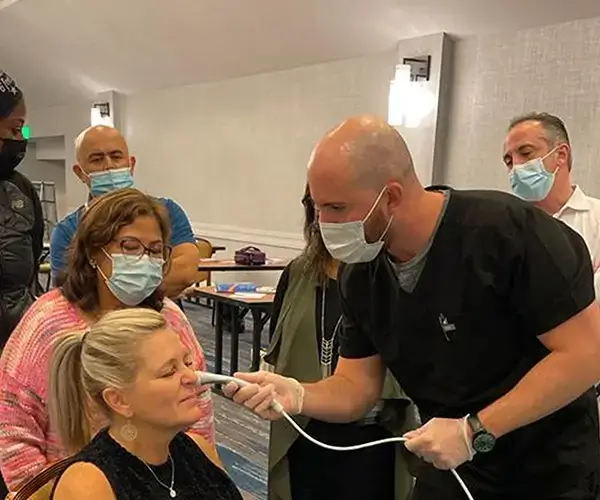How to Find Best Chemical Peel Classes
By Dr. Stephen Cosentino
PRESIDENT OF EMPIRE MEDICAL TRAINING
Sometimes, even the most diligent skincare routine falls short in combating the signs of aging. As we grow older, our facial skin loses volume and elasticity, resulting in noticeable droops, folds, fine lines, and wrinkles. While traditional plastic surgery can address these concerns, it's often unnecessary for many patients and may not be medically indicated for others. Injectable treatments like Botox® and dermal fillers offer temporary relief with reduced risk, but their cost and potential side effects can be deterrents for some patients.
Fortunately, these aren't the only options available for those seeking to enhance their appearance and boost their confidence. One effective alternative is the chemical peel, a procedure that gently revitalizes the skin and can temporarily diminish the appearance of fine lines and wrinkles. If you're an aesthetic practitioner looking to incorporate chemical peels into your practice, here's what you need to know about the training process.
Understanding Chemical Peel Training
Chemical peel classes provide hands-on training for aestheticians and medical providers who wish to add this discipline to their practice. These courses typically span one to two days and should cover a comprehensive range of topics, including:
- Skin anatomy and physiology
- Chemical peel types and their applications
- Patient assessment and selection
- Pre-treatment protocols
- Proper application techniques
- Post-treatment care and potential complications
- Legal and ethical considerations
Both online and in-person courses should include live or recorded demonstrations with actual patients. In-person courses should allow trainees to practice techniques on live patients, providing invaluable hands-on experience.
Eligibility and Regulations
Before enrolling in a chemical peel course, verify your eligibility to perform these procedures in your state. State boards of cosmetology typically set chemical peel regulations, including:
- Which medical and aesthetic professionals can perform chemical peels
- The types of peels different professionals are authorized to perform
These regulations vary by state but often restrict licensed cosmetologists from performing deep chemical peels, reserving those for board-certified medical professionals. Depending on your current certification level and future career aspirations, you may need to pursue a higher credential (such as a nursing degree) before enrolling in a chemical peel course for healthcare professionals.
Choosing the Right Course
When selecting a chemical peel training program, consider the following options:
1. Standalone Chemical Peel Classes
Look for courses that cover the topics and objectives mentioned earlier. Ensure that the program includes:
- Comprehensive coverage of chemical peel techniques
- Live demonstrations or hands-on training opportunities
- A chemical peel certificate upon successful completion
2. Comprehensive Facial Aesthetic Training
If you're interested in expanding your skills beyond chemical peels, consider a more comprehensive facial classes course. These programs often cover additional disciplines such as:
- Botox and other neuromodulator injections
- Dermal filler applications
- Microneedling techniques
- Laser treatments
- Thread lifts
Key Factors to Consider
When evaluating chemical peel training programs, keep the following factors in mind:
1. Accreditation
Verify that the course administrator is accredited by relevant professional organizations or educational institutions. This ensures that the training meets industry standards and is recognized within the field.
2. Hands-on Experience
Practical experience is invaluable in mastering chemical peel techniques. Prioritize courses that offer live demonstrations and hands-on training with actual patients or realistic simulators.
3. Certification
Ensure that the course provides a recognized chemical peel certificate upon successful completion. This certification provides professional credibility and may be required by some employers or state regulations.
4. Instructor Expertise
Research the qualifications and experience of the course instructors. Ideally, they should be practicing professionals with extensive experience in chemical peel procedures and a strong background in aesthetic medicine.
5. Course Materials
Inquire about the course materials provided. Comprehensive training should include detailed manuals, video resources, and ongoing support for graduates.
The Benefits of Chemical Peel Training
Investing in chemical peel training can offer numerous benefits for aesthetic practitioners:
- Expanded service offerings for your practice
- Increased patient satisfaction and retention
- Enhanced skills in skin assessment and treatment planning
- Potential for increased revenue
- Improved understanding of skin physiology and treatment outcomes
Continuing Education and Advanced Training
The field of cosmetic dermatology is constantly evolving, with new techniques and products emerging regularly. After completing your initial chemical peel training, consider pursuing continuing education opportunities to stay current with the latest advancements. This might include:
- Advanced chemical peel workshops
- Conferences and seminars focused on aesthetic treatments
- Online courses covering new products or techniques
- Manufacturer-sponsored training for specific product lines
Conclusion
Chemical peel training can be valuable to any aesthetic practitioner's skill set. By choosing a comprehensive, accredited program that offers hands-on experience, you can confidently add this effective treatment option to your practice. Remember to verify your eligibility based on state regulations and consider your long-term career goals when selecting a training program. With the right education and ongoing professional development, you can provide your patients with safe, effective chemical peel treatments that help them achieve their aesthetic goals.


